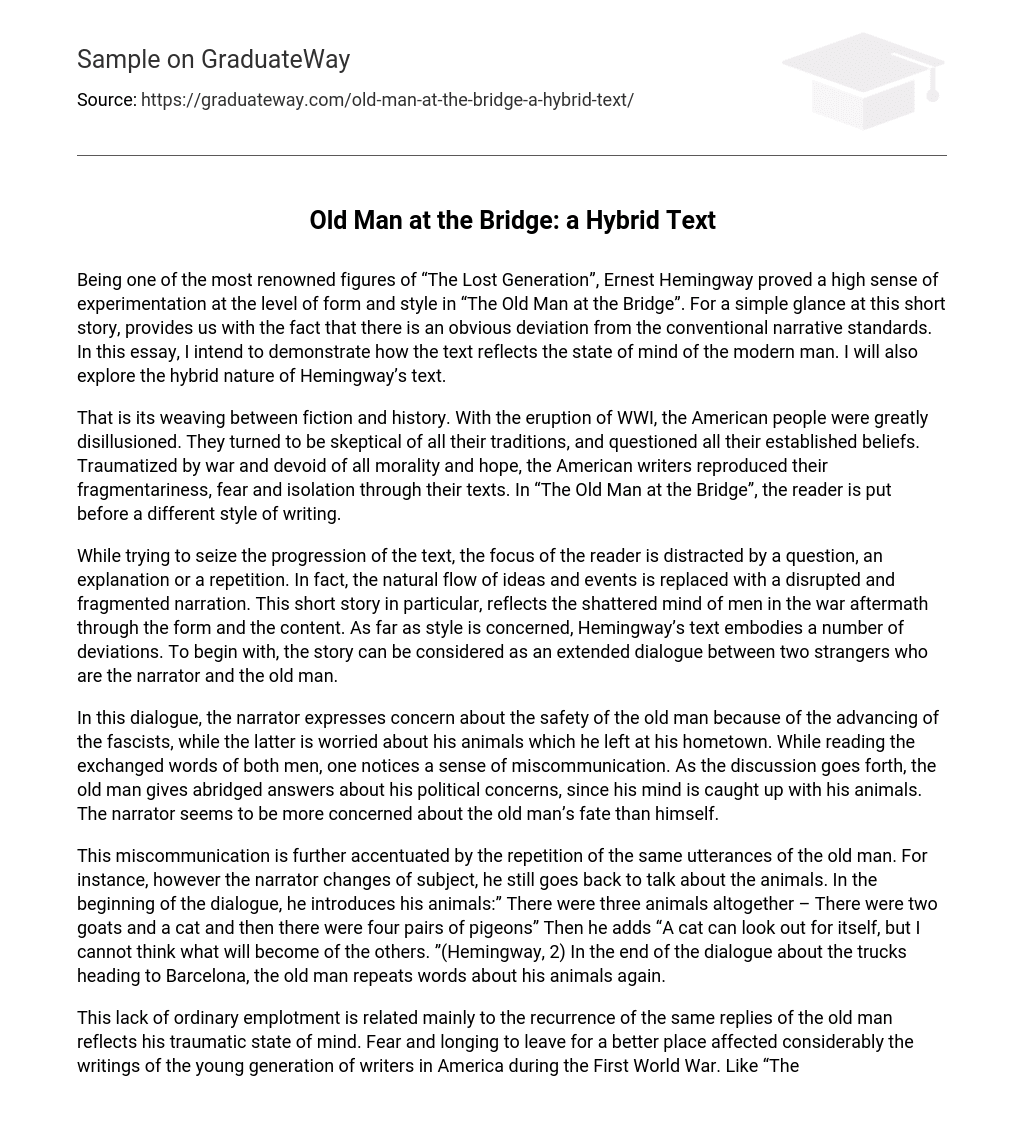Ernest Hemingway, known as one of the prominent figures of “The Lost Generation,” showcased his penchant for experimenting with form and style in “The Old Man at the Bridge.” This short story diverges from traditional narrative norms, providing a clear indication of its departure. This essay seeks to showcase how the text mirrors the mindset of contemporary individuals and delves into the mixed characteristics present in Hemingway’s writing.
That is its weaving between fiction and history. With the eruption of WWI, the American people became highly disillusioned, causing them to become skeptical of their traditions and question their established beliefs. Traumatized by the war and lacking any sense of morality and hope, American writers reflected their fragmented state, fear, and isolation in their texts. In “The Old Man at the Bridge,” the reader encounters a distinctive style of writing.
The text interrupts the reader’s concentration with inquiries, clarifications, and duplications, substituting the organic progression of thoughts and occurrences with a disjointed storytelling. This brief narrative mirrors the fractured psyches of individuals post-war in both structure and substance. Regarding its stylistic elements, Hemingway’s writing showcases numerous deviations. It can be interpreted as a prolonged conversation between two unfamiliar individuals: the narrator and the elderly gentleman.
In this dialogue, there is a mutual expression of worry regarding different aspects. The narrator is concerned about the old man’s safety from advancing fascists, while the old man frets over his animals left behind in his hometown. Throughout their conversation, miscommunication becomes evident as the old man primarily focuses on his animals and only briefly responds to political concerns. Interestingly, the narrator appears to be more anxious about the old man’s fate rather than their own.
The miscommunication in the text is emphasized by the repeated utterances of the old man. Despite the narrator changing the subject, the old man consistently returns to discussing the animals. At the beginning of their conversation, he introduces his animals, stating: “There were three animals altogether – There were two goats and a cat and then there were four pairs of pigeons.” He continues, saying: “A cat can look out for itself, but I cannot think what will become of the others” (Hemingway, 2). Towards the end of their discussion about the trucks heading to Barcelona, the old man repeats his concerns for the animals once again.
The old man’s repetitive responses in “The Old Man at the Bridge” demonstrate his traumatized state of mind and the absence of regular employment. During the First World War, the American writers of the younger generation were greatly influenced by their fears and desire to escape to a more favorable environment. In his works, Hemingway, like “The Old Man at the Bridge,” used hybrid texts that merged history with fiction to depict the psychological condition of men during that time.
Therefore, Hemingway employed a combination of historical and fictional elements to create a symbolic and more indirect representation. Ruth Leys, a prominent psychoanalysis scholar, asserts in her book Trauma: A genealogy that this fusion and juxtaposition produce a puzzle-like narrative, offering a complete storytelling experience that is more satisfying to readers’ curiosity and desires than a straightforward linear plot (Leys, 61[1]). Consequently, instead of presenting a coherent and polished storyline, the author adopts a minimalist yet highly symbolic style that reflects the common encounters of war, destruction, and devastation. This harsh reality led to fragmentation and the disintegration of individuals. In Hemingway’s short story, the old man can be viewed as a perfect embodiment of the lost, amnesiac, and vulnerable individual during wartime. The old man’s decision not to leave at the end may symbolize the inevitable fate of death. Such nihilism and self-destruction are only fully understood when reflecting on the era of war and its immense destruction.
Hemingway’s use of symbolism effectively illustrates the various implications of war, such as despair, displacement, and moral decay. The juxtaposition of historical war conditions and fictional character encounters in his writing serves to analyze the consequences of war and expose its profound psychological effects. “The Old Man at the Bridge” particularly exemplifies the post-war mindset of individuals.
The short story represents amnesia and trauma in men through a fragmented narrative style, paralleling the troubled psychological state of a man after war. Hemingway, a figure of the ‘Lost Generation,’ uses ‘Historytelling’ to depict the unbearable and tragic conditions that caused ethics and morality to vanish from the modern man’s mind.





